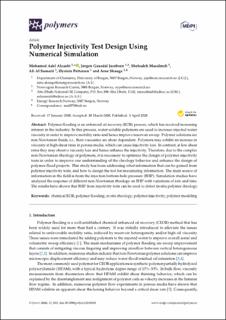| dc.contributor.author | Alzaabi, Mohamed Adel | |
| dc.contributor.author | Jacobsen, Jørgen Gausdal | |
| dc.contributor.author | Masalmeh, Shehadeh | |
| dc.contributor.author | Al Sumaiti, Ali | |
| dc.contributor.author | Pettersen, Øystein | |
| dc.contributor.author | Skauge, Arne | |
| dc.date.accessioned | 2021-06-22T11:20:11Z | |
| dc.date.available | 2021-06-22T11:20:11Z | |
| dc.date.created | 2020-09-25T16:24:10Z | |
| dc.date.issued | 2020-04-03 | |
| dc.Published | Polymers. 2020, 12 (4), . | |
| dc.identifier.issn | 2073-4360 | |
| dc.identifier.uri | https://hdl.handle.net/11250/2760612 | |
| dc.description.abstract | Polymer flooding is an enhanced oil recovery (EOR) process, which has received increasing interest in the industry. In this process, water-soluble polymers are used to increase injected water viscosity in order to improve mobility ratio and hence improve reservoir sweep. Polymer solutions are non-Newtonian fluids, i.e., their viscosities are shear dependent. Polymers may exhibit an increase in viscosity at high shear rates in porous media, which can cause injectivity loss. In contrast, at low shear rates they may observe viscosity loss and hence enhance the injectivity. Therefore, due to the complex non-Newtonian rheology of polymers, it is necessary to optimize the design of polymer injectivity tests in order to improve our understanding of the rheology behavior and enhance the design of polymer flood projects. This study has been addressing what information that can be gained from polymer injectivity tests, and how to design the test for maximizing information. The main source of information in the field is from the injection bottom-hole pressure (BHP). Simulation studies have analyzed the response of different non-Newtonian rheology on BHP with variations of rate and time. The results have shown that BHP from injectivity tests can be used to detect in-situ polymer rheology. | en_US |
| dc.language.iso | eng | en_US |
| dc.publisher | MDPI | en_US |
| dc.rights | Navngivelse 4.0 Internasjonal | * |
| dc.rights.uri | http://creativecommons.org/licenses/by/4.0/deed.no | * |
| dc.subject | Reologi | en_US |
| dc.subject | Rheology | en_US |
| dc.subject | Polymer flooding | en_US |
| dc.subject | Chemical EOR | en_US |
| dc.subject | Polymere | en_US |
| dc.subject | Polymers | en_US |
| dc.title | Polymer Injectivity Test Design Using Numerical Simulation | en_US |
| dc.type | Journal article | en_US |
| dc.type | Peer reviewed | en_US |
| dc.description.version | publishedVersion | en_US |
| dc.rights.holder | Copyright the authors | en_US |
| dc.source.articlenumber | 801 | en_US |
| cristin.ispublished | true | |
| cristin.fulltext | postprint | |
| cristin.qualitycode | 1 | |
| dc.identifier.doi | 10.3390/polym12040801 | |
| dc.identifier.cristin | 1833632 | |
| dc.source.journal | Polymers | en_US |
| dc.source.40 | 12 | |
| dc.source.14 | 4 | |
| dc.relation.project | Norges forskningsråd: 267804 | en_US |
| dc.subject.nsi | VDP::Berg- og petroleumsfag: 510 | en_US |
| dc.subject.nsi | VDP::Rock and petroleum sciences: 510 | en_US |
| dc.identifier.citation | Polymers. 2020, 12 (4), 801. | en_US |
| dc.source.volume | 12 | en_US |

